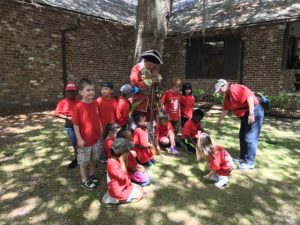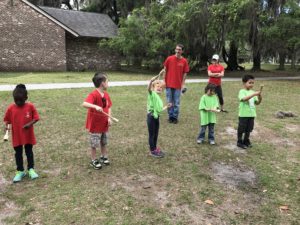Tom and I love to talk to school groups. At Chickamauga and Kings Mountain, we had lots of 4th graders who visited to learn more about state history. Here at Fort Frederica we give presentations to middle school students frequently. But the last couple of weeks we worked with a new age group: Kindergartners. About 100 Kindergartners per day.
Middle School kids will pay attention to you 95% of the time. 4th graders pay attention about 80% of the time. This, of course, is predicated on you presenting things in an interesting way that keeps their attention. Kindergartners are another matter entirely. If you can get one out of five to pay attention for more than five minutes, you must be doing something pretty interesting. If you can get the attention of three out of five at one time, you are doing amazing things. Getting the attention of all of them at once – would be a miracle. It is never going to happen.
 Usually Tom gives a musket talk that lasts about 20 minutes. He explains the uniform, what a soldier carried, and the steps in firing a musket. This works fine for kids in 4th grade and up. With the Kindergartners, he pretty much shoots and tries to get them lined up for a picture with him. If he can fire a couple of times without any of them scooting under the protective rope, he feels like his presentation is a success. Just getting the picture can take 10 minutes easy.
Usually Tom gives a musket talk that lasts about 20 minutes. He explains the uniform, what a soldier carried, and the steps in firing a musket. This works fine for kids in 4th grade and up. With the Kindergartners, he pretty much shoots and tries to get them lined up for a picture with him. If he can fire a couple of times without any of them scooting under the protective rope, he feels like his presentation is a success. Just getting the picture can take 10 minutes easy.
 I play Colonial games with the Kindergartners. We go into the palmetto hut where we play “pretend” and try not to get any of them tangled up in the bed ropes. Then we try “Ball in the Cup” which is a game where you try to get a ball on a string into the cup it is attached to. About eight kids at once can play. If more than that play, they start whacking each other on the head with the ball. A couple of times they have even whacked each other with the cup.
I play Colonial games with the Kindergartners. We go into the palmetto hut where we play “pretend” and try not to get any of them tangled up in the bed ropes. Then we try “Ball in the Cup” which is a game where you try to get a ball on a string into the cup it is attached to. About eight kids at once can play. If more than that play, they start whacking each other on the head with the ball. A couple of times they have even whacked each other with the cup.
Because “Ball in the Cup” requires some hand-eye coordination, only two out of hundreds of Kindergartners have been able to get the ball in the cup. This game works best when it is the adults’ turn to try to get the ball in the cup. The kids usually pick a couple of adults to cheer for – the teacher or a parent. And they are quite impressed when one of the adults gets the ball in the cup. They are also very good at encouraging the adults.
For a while I tried to play “The Game of Graces” with the Kindergartners. In “The Game of Graces” you toss a wooden ring using two sticks that you pull apart. Then someone else tries to catch the ring and throw it back at you. I modified the game so I was the only one tossing (pulling the sticks apart too hard results in the ring becoming a lethal projectile). I gave each child a stick and had them catch the ring as two of them stood before me. Some of them were pretty good at it, but there were too many of them standing around. Also, it took about five minutes to get 20 of them into two lines.
 So I finally came up with a game that was very popular and successful, “Fox and Geese.” This game looks a lot (exactly) like “Duck, Duck, Goose.” The only difference is you yell “fox” when you tap the child on the head, and you run around everything until you decide to get back in the circle. And by everything, I mean the stump, the teachers, the palmetto hut. “Fox and Geese” works best when you have enough time that every child has a turn. Otherwise you inevitably have one child crying “but I didn’t get to go!” If I ran out of time for everyone to go, I told them they were all foxes and I was the goose and they had to catch me.
So I finally came up with a game that was very popular and successful, “Fox and Geese.” This game looks a lot (exactly) like “Duck, Duck, Goose.” The only difference is you yell “fox” when you tap the child on the head, and you run around everything until you decide to get back in the circle. And by everything, I mean the stump, the teachers, the palmetto hut. “Fox and Geese” works best when you have enough time that every child has a turn. Otherwise you inevitably have one child crying “but I didn’t get to go!” If I ran out of time for everyone to go, I told them they were all foxes and I was the goose and they had to catch me.
Even getting the kids to stand in a circle is a challenge. You would think they had never heard the term before in their lives. I don’t know how Kindergarten teachers do it. I have been saying a special prayer for Kindergarten teachers every day since. Thank you, God, for the special people who have the patience and stamina to teach classes of these children.
I loved having the Kindergartners visit. Working with them was fun and exhausting. Five and six year olds are wonderful, but I prefer mine in smaller doses – one or two at a time.

One comment